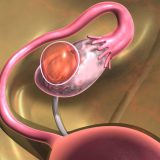To start learning the question whether the sinus cyst can be cancerous, let’s give a definition to a cyst. Here we will talk about a cyst as a pathological tumor in a cavity form. Hence, it is a cluster of cells that has grouped together.
The maxillary sinus cyst is the cavity in the related organ, which is nose. Unfortunately, the tumors in a nose can be either benign or malignant.
Benign sinus cyst or malignant
The prossesof the g cyst development can continuing slowly over several years without symptoms. But its signs are similar to cancerous cyst.
At the same time, the malignant tumor symptoms are often just ignored by people. But the formations in a nose can quickly develop and grow, affecting the surrounding tissue. All it leads to awful consequences. And with growing, the tumor can extend beyond the nasal cavity in different directions.
If it grows forward, it come out to the corresponding half of the nose and penetrates out through the hole. In this case there is a deformation of the nose and facial asymmetry.
If the tumor spreads in the opposite direction, it can grow into the nasopharynx, causing dysfunction of the Eustachian tube. And through the lattice maze it can get in the orbit, causing the appearance of exophthalmus.
Often the tumor spreads downwards, affecting the jaw and sprouting into the base of the skull.
Actually, the rhinoscopic clinical picture of the cancer may be different. If we are talking about an isolated lesion of the nasal cavity, there are various sizes possible.
The color of malignancies can range from bright red to gray with a chalky white tint. Externally, nose cancer can look different. The tumor may resemble an ordinary benign cyst.
Distinguish maxillary sinus cyst and nasal cancer
Only a doctor can confirm or exclude the fear whether the sinus cyst be cancerous.
In addition, people should remember that the earlier the tumor is detected, the higher the success of the treatment.
After inspection by a medical specialist and preliminary examination, there may be recommend additional methods of screening.
- X-ray examination of the paranasal sinuses allows to judge about the state of the sinuses, to identify inflammatory or tumor process in the sinuses and nearby lymph nodes and to appoint an additional examination.
- Computed tomography (CT), in some cases with additional contrast, is an effective method of diagnosing tumors of these localizations.
- Magnetic resonance imaging (MRI) can provide additional information and can distinguish a malignant tumor from a benign maxillary sinus cyst.
- Biopsy (taking a piece of tumor for microscopic examination) is a mandatory final examination method that allows to make a final diagnosis and determines the plan of treatment. Without this histological examination it is impossible to find out whether the tumor is just a polyp or a malignant tumor.
The tumor turns out to be a cancer rather often. That is why one better go to a doctor when have a suspicious that there is a tumor. To understand it in time, people must pay attention to maxillary cancer symptoms.
Maxillary sinus cancer symptoms
The pathological process can not manifest itself for a long time. At the beginning, the nose cancer symptoms are absent or poor expressed. The first signs usually begin to appear at the moment when the tumor has grown to a large size. When it has stretched and closed space of the sinuses.
Symptoms and signs of the nose cancer vary. At the initial stage of development, the symptoms are similar to the symptoms of various diseases – rhinitis, sinusitis and other disorders, a person has his nose stuffed up.
But not only the progressive nose cancer growth affects breathing difficulties. Maxillary sinus cancer is always accompanied by nose bleeding. In the early stages, they are quite rare and insignificant. And with the growth of tumors the bleeding become more frequent, abundant and can be threatening. In addition, patients may develop purulent inflammation of the middle ear and catarrh of the Eustachian tube.
With time the disease develops, patients may complain of headache. It can be triggered by a change in weather conditions or in contact with allergic substances. At this point, blood pressure begins to rise, which creates some difficulties in diagnosing the disease.
There appear unpleasant feelings, pain in the sinuses, changes in the sense of smell. The nose is constantly blocked, there are permanent mucous.
Then there is added another symptom: the purulent exudate. And with the proliferation of the nose cancer in different directions, the tumors at the top further complicate the breathing. Down proliferated maxillary sinus cancer gives difficulties in eating and difficulty in opening the mouth. As the nasal cancer has grown in the mastication muscles. Nasal sinus cancer often affects the hard palate and upper jaw. This leads to tooth loss, the appearance of wounds on the gums. Maxillary sinus cancer also can lead to displacement and loss of eyes, facial deformity.
A sinus cyst can be cancerous
The tumor which is the cyst can be cancerous, but bot always. People should pay attention to their health and don’t ignore bad feelings that are the symptoms. There must be a habit to visit a doctor sometimes Only he can examine a patient and find out whether there is a risk of maxillary sinus cancer.














